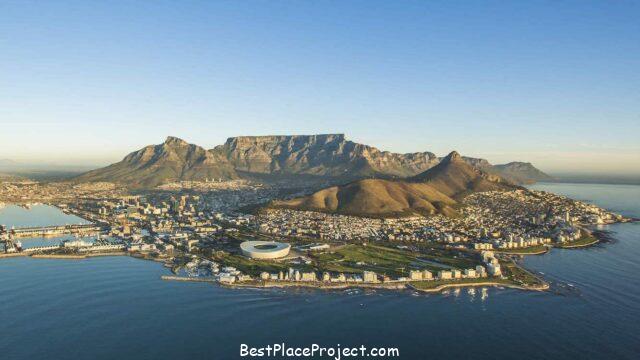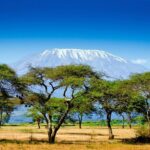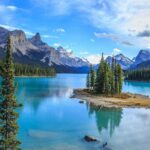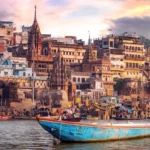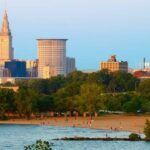The Western Cape Province curves alluringly around its capital, Cape Town, which sits between mountains and the sea in one of the most beautiful places in the world.
This very photogenic province is home to two of South Africa’s most famous landmarks: Table Mountain and Cape Point. Cape Agulhas, where the Indian and Atlantic Oceans meet, is the southernmost point of Africa.
Along the coast, whales swim in the clear, cool water, penguins waddle along the white-sand beaches, and tourists can walk on trails cut into the rough cliffs above the crashing sea.
From Cape Town, the countryside rolls out into farmland and charming Cape Dutch towns like Stellenbosch, Swellendam, and Oudtshoorn, which is known as the ostrich capital of the world. Farther inland, the Great Karoo and nearby parks have stark, semi-desert landscapes that are a great contrast to the lush coast.
Here, people can take pictures of twisted, rust-colored rock formations, seas of colourful wildflowers, and fields that seem to go on forever of fynbos, the native scrub.
On the Garden Route, which is one of the most beautiful drives in the country, travellers can also see some of the Western Cape’s coast.
Our list of the best places to visit in the Western Cape will help you find the best places to see in this varied area.
18. Table Mountain, Cape Town
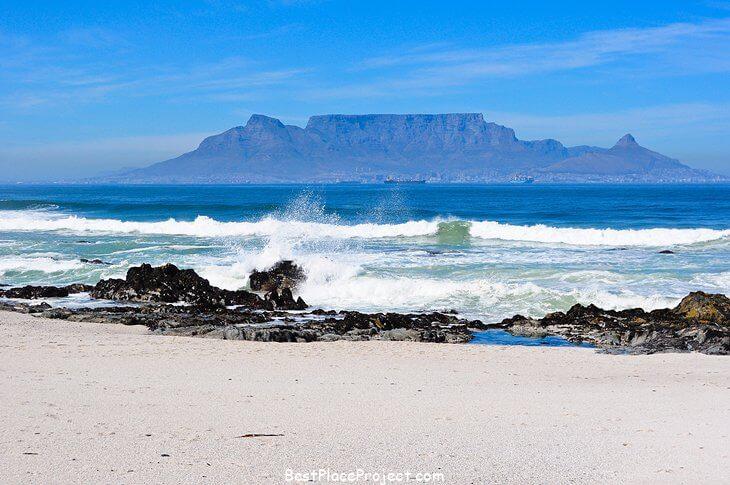
Table Mountain is one of the most photographed places in South Africa, so no tourist should leave Cape Town without taking a picture of it. This famous landmark with a flat top rises 1,087 metres above the city centre and invites both locals and tourists to sit on its panoramic plateau and take in the beauty of this lovely city.
The mountain, which is made of thick layers of sandstone and slate, is the crown jewel of Table Mountain National Park, which protects a huge variety of plants and animals.
The best time to climb to the top of Table Mountain is when the “tablecloth” of clouds that often forms a fluffy duvet over the top of the mountain is gone. If people go at the right time, they can get amazing views of Cape Town and the whole Cape Peninsula from the top.
The easiest way to get to the top of this famous landmark is to take the cable car, which runs every day except when there are strong winds. Once visitors get to the top, they can go on three short nature walks or just sit on the deck of the café and look out at the view.
Climbers who want to walk up the mountain can choose from more than 350 routes that are made for different skill levels. It can take anywhere from two to four hours to reach the top.
If you want to take pictures of the mountain itself instead of the view from the top, hike or drive up nearby Signal Hill or Lion’s Head. Both offer great views of the mountain. Kirstenbosch Botanical Gardens is another must-see in Cape Town. It is part of the Cape Floristic Region UNESCO World Heritage site and is set in a beautiful place on the eastern slopes of Table Mountain.
17. Robberg Nature Reserve, Plettenberg Bay
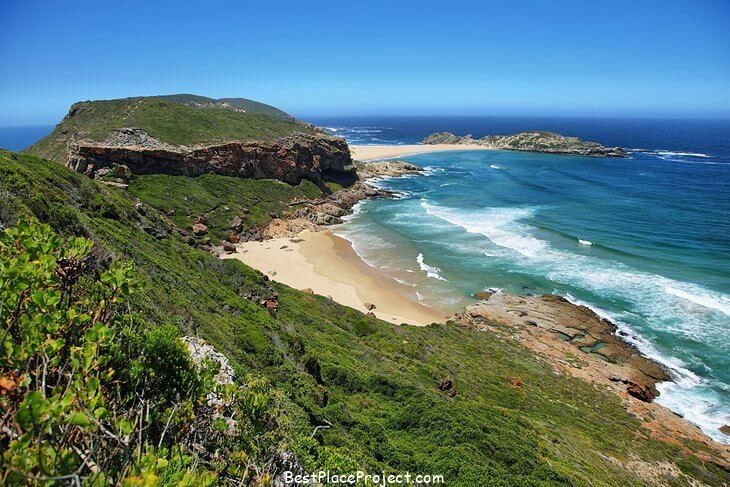
The Robberg Nature Reserve is one of the best places to visit on the famous Garden Route. The Garden Route is a 200-kilometer scenic drive that goes from Mossel Bay in the Western Cape to Storms River in the Eastern Cape.
The Robberg Nature Reserve is about eight kilometres from the popular beach town of Plettenberg Bay. This beautiful reserve is on a four-kilometer-long peninsula at the foot of the Mountain of the Seal, where some of the rocks are very old and have been there for thousands of years.
Hikers will be in heaven here. On the peninsula, there are many beautiful trails with varying levels of difficulty, but the best one is the 10-kilometer hike around the point.
Along the way, you’ll see rugged sea cliffs and beautiful beaches. There are a lot of birds, especially water birds, and some of them live and breed here.
Seals sunbathe on the beach and play in the water. When it’s the right time of year, whales and dolphins swim along the coast. Also, keep an eye out for great white sharks.
At the parking lot’s visitor centre, you can get information about the plants and animals in the area.
16. Boulders Penguin Colony
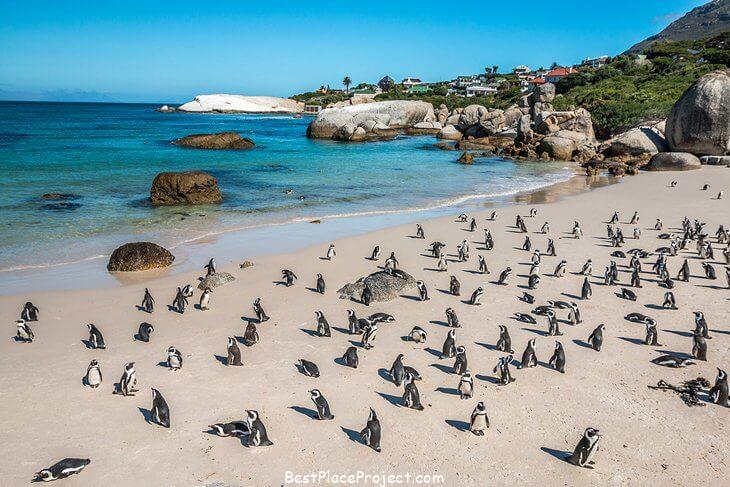
The Boulders Penguin Colony is a must-see for people who love animals. It has three beautiful beaches where these cute animals waddle along the clean, white sands.
More than 2,000 endangered African Penguins live on the beaches of Simon’s Town, which is about an hour’s drive from Cape Town.
Visitors can get close to the penguins and paddle in the clear, calm water. Large granite rocks protect the bay from winds and currents, making it a great place for kids to swim.
A short walk away is Foxy Beach, which has a boardwalk that goes by the best places to see penguins.
The beaches are in a marine protected area that is part of Table Mountain National Park. The park charges a daily conservation fee to help protect the area.
15. Cape Point
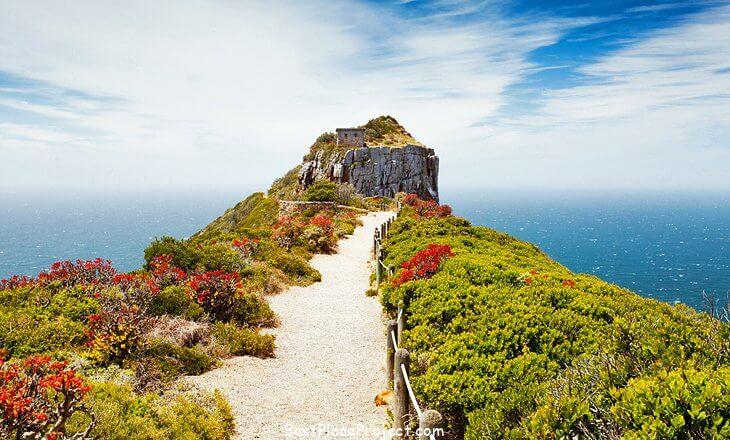
Cape Point is one of the most popular day trips from Cape Town. It is about 60 km away. Not only is this the most southwestern point of Africa, but it is also part of the Cape Floral Region, which is a UNESCO World Heritage Site and has one of the most diverse plant communities on Earth. There are also more than 250 different kinds of birds.
Visitors can climb the stairs or, better yet, take the Flying Dutchman funicular to the top of the Cape Point Lighthouse to see the amazing view.
Other things to do here include walking along the nature trails, watching whales, and spotting wildlife. Look for Cape zebra and eland, and watch out for the cheeky baboon troops.
Getting to this faraway piece of land can be just as beautiful as being there. The drive along the Cape Peninsula takes you through cute beach towns and to Boulders Bay, where you can see penguins on the beautiful beaches.
On the way back, travellers can take Chapman’s Peak Drive, which winds along steep sea cliffs and offers amazing views of the sunset.
14. Karoo National Park
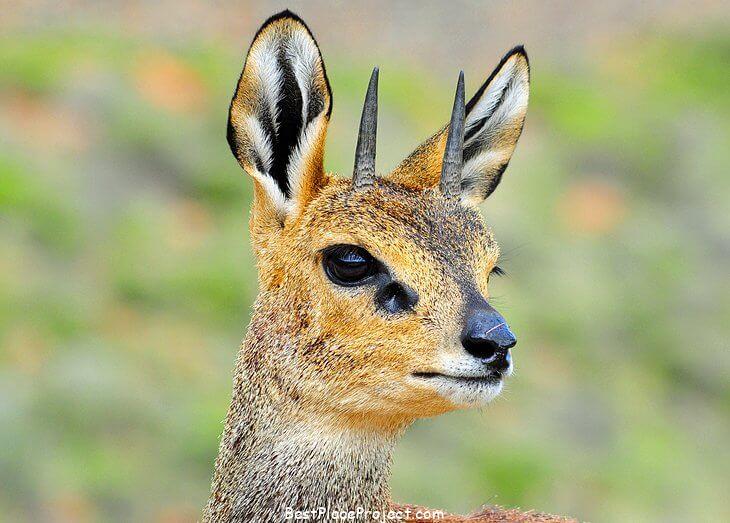
Karoo National Park is a hauntingly beautiful place just outside of the town of Beaufort West. There, the flattened peaks of the Nuweveld Mountains rise above vast, red-earthed semi-desert landscapes with greens and golds dotted throughout.
The park was set up in 1979 and is an important fossil site. It is part of the Great Karoo, which is South Africa’s largest ecosystem, and is a part of the park.
It protects many endemic species, like buffalo and rhino, as well as reintroduced species, like Cape mountain zebras, springboks, kudus, lions, and brown hyenas. People often see oryx and klipspringer here, and the bat-eared fox does well in the dry climate.
Birdwatchers also have the chance to see one of the rare breeding pairs of the Verreaux’s Eagle, as well as a wide range of smaller species that is hard to believe. Some of the best things about the park are Klipspringer Pass, Rooivalle View Point, and the Fossil Trail. Stop by the Ou Schuur Interpretation Centre to learn interesting things about the park.
People often stop at Karoo National Park on their way from Cape Town to Johannesburg. The park has comfortable cottages in the Cape-Dutch style for visitors to stay in. Note that some of the tracks only allow 4WD vehicles.
Christiaan Barnard, a well-known heart surgeon, was born in Beaufort West, which is the entrance to the Karoo. Barnard won a lot of awards and honours, and many of them are on display in the town museum, which is close to the small parsonage where he lived as a child.
13. Stellenbosch
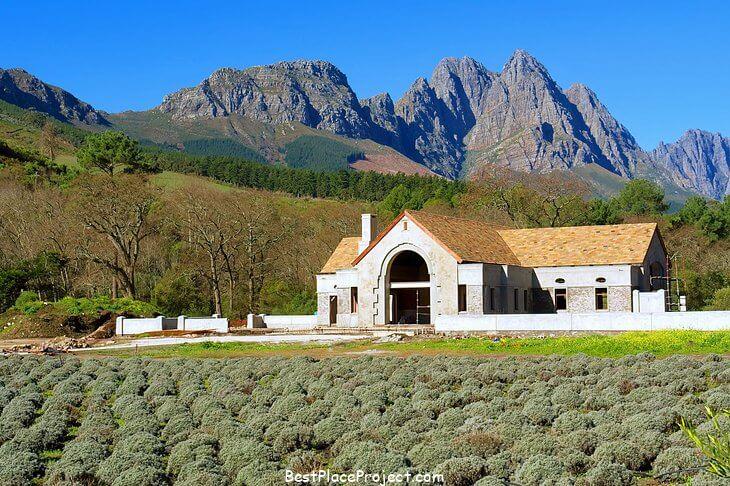
Elegant Stellenbosch, which is the second oldest European settlement on the Cape, is a nice place to go for a day trip from Cape Town. Visitors are greeted by fields covered in vines, old oak trees, and streets with cobblestones. Charming Cape Dutch-style buildings give the town the feel of a bygone era.
Stellenbosch is also known for its rich soil and fresh food, which tourists can try at a number of gourmet restaurants and cafes. Stellenbosch University is South Africa’s oldest and most well-known school, and the students give the town a lively feel. Stop by the University Botanic Gardens to see native succulents, orchids, cycads, and welwitschias, which grow in the Namibian deserts.
The Village Museum, a collection of four houses from 1709 to 1850 that have been carefully restored and furnished in their original style, and the Rupert Museum, which focuses on South African art, are also worth seeing.
The Jonkershoek Nature Reserve is close to town and has some of the best hiking and biking trails in the area. While in the area, people can visit the nearby towns of Paarl and Franschhoek to enjoy more delicious food and beautiful countryside.
12. The Wildflowers and Birds of West Coast National Park

Birders love West Coast National Park, which is about 90 minutes by car from Cape Town. This coastal park was set up in 1985. It includes the Langebaan Lagoon and four small islands off the coast.
More than 250 kinds of birds live in the park, and many birds that spend the winter in the Arctic migrate there. Cormorants, seagulls, small sandpipers, curlew sandpipers, plovers, gannets, flamingos, and the black-footed penguin are just a few of the many species that live there.
There is also a lot of wildlife, but this is not the place to see Africa’s “Big Five.” Among the mammals are bontebok, eland, springbok, kudu, and blue wildebeest. A paved road goes all the way around the lagoon, where there are bird hides and places to look out.
At the south end of the lagoon, in the old farmhouse of Geelbek, there is a visitor centre that also serves as the start of several nature trails. Visitors can also go on a cruise on the lagoon to watch birds.
In addition to birding, people like to hike and bike on the nature trails, kayak on the lagoon, and take pictures of the wildflowers that cover the barren landscapes here from August to September.
11. Knysna Heads, The Garden Route
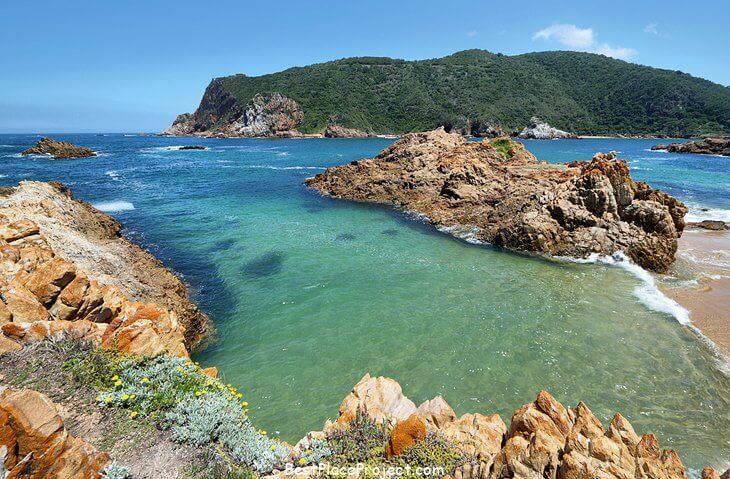
The beautiful Knysna Heads are one of the most popular places to visit along the Garden Route. The Garden Route is a scenic drive that goes from Mossel Bay in the Western Cape to Storms River in the Eastern Cape.
It is more than 200 kilometres long. These two huge cliffs tower over a sparkling lagoon and offer many great views of the crashing waves below and the rough and rocky coast.
There are hiking trails all over the heads, and sightseeing boats offer a great view of the area from the water. People can also hang out at one of the cafés in the area and eat while taking in the view. Knysna is also known for its oysters.
The town has an annual oyster festival in late June or early July to celebrate the oysters. Hikers can look for wildlife in the forests around Knysna.
There are yellowwood trees that are hundreds of years old and beautiful Cape chestnuts with pink flowers where elephants used to roam.
10. Hermanus: Whale Watching and Water Sports
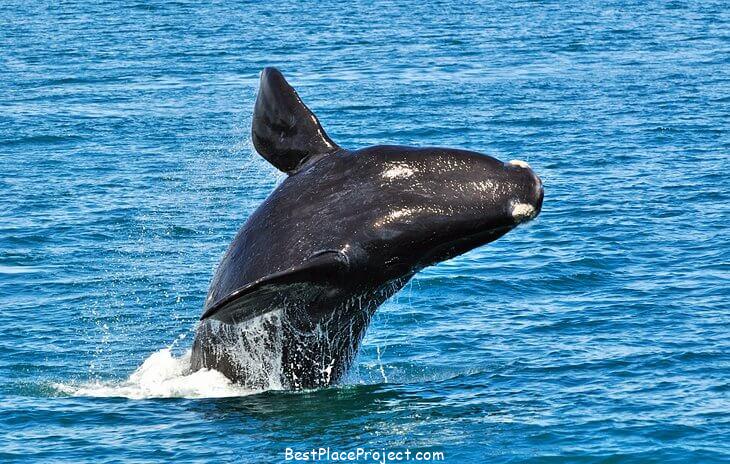
Hermanus is a popular vacation spot about 120 km east of Cape Town. It is also one of the best places in the world to see whales close to shore.
From July to November, a lot of southern right whales swim along this coast. Every September, the town holds the Whale Festival to honour these gentle giants.
Aside from this amazing wildlife show, the best things to see here are the beautiful sandy beaches to the east of town and the great places to do water sports.
Many people go fishing in the coastal waters because they have seen some record catches. The area around the harbour, which is the heart of the town, is small and easy to get around on foot. Restored fishermen’s houses are now restaurants and shops.
The Cliff Path, which is 12 kilometres long, and the Fernkloof Nature Reserve, which is just outside of town and has many beautiful birds and hiking trails through native fynbos and proteas, are also great places to visit.
When the number of tourists doubles from December to January, the best time to book a room in Hermanus is well ahead of time.
The De Hoop Nature Reserve is about two hours away by car. It has a beautiful stretch of coast and a beautiful area behind it with 1,400 species of plants, some of which are very rare, and 63 species of mammals (50 of them on land and 13 in the sea).
9. Cederberg Wilderness Area
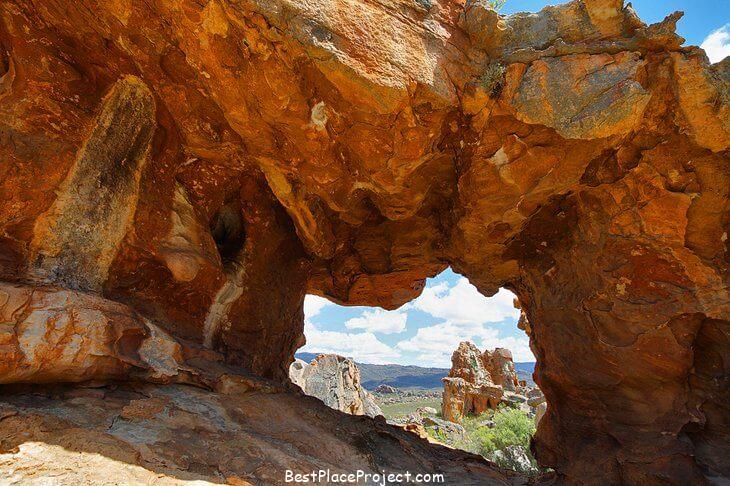
About 300 kilometres north of Cape Town, the rough Cederberg Wilderness Area impresses photographers with its wide-open views and strange red-tinged rock formations.
The Cedarberg is also known for its wooded gorges, Bushman paintings in caves, and unique plants, like the white snow protea, which only grows in this area.
The Cederberg is a range of hills about 100 kilometres long, stretching from Clanwilliam in the north to Ceres in the south. It was named for the many cedar trees that used to grow there.
The Sneeuberg is its highest point (2,028 meters). The area is full of hiking trails, and it’s no surprise that rock climbing is also popular.
Between September and April is the best time to visit the Cederberg, especially between September and October when the wildflowers are in bloom.
In the fertile valley of the Olifants River, the town of Clanwilliam is a great starting point for trips to the Cederberg Wilderness Area, with its Cape Dutch-style buildings, the Rooibos Teahouse, and the beautiful Ramskop Nature Reserve, which is full of colourful wildflowers in August and September.
North of Clanwilliam, a beautiful road winds up to the Pakhuis Pass, where you can see the whole area. The beautiful Biedouw Valley is 32 kilometres away from Clanwilliam. It has strange rock formations and beautiful spring flowers. Stop by the cute little town of Wupperthal, which has whitewashed cottages with thatched roofs.
8. Cape Agulhas
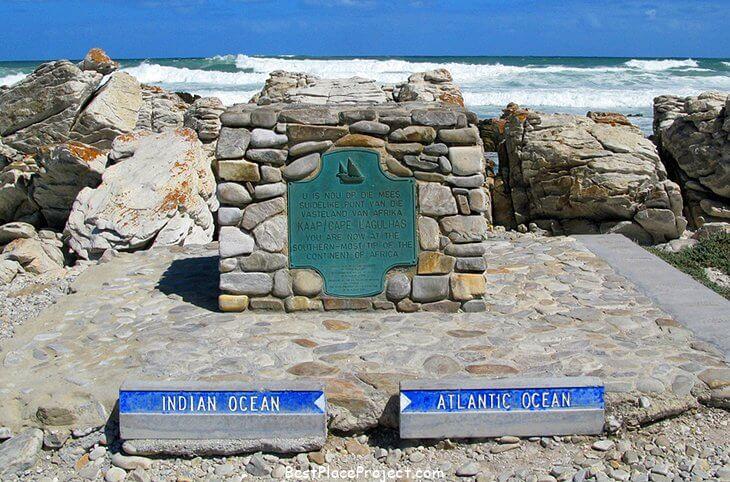
Cape Agulhas is the southernmost point of both the Republic of South Africa and the continent of Africa. It is about 220 kilometres from Cape Town.
A small cobalt blue sign says that this is where the Atlantic Ocean and the Indian Ocean meet. Even though it’s not as beautiful as South Africa’s most southwesterly point, Cape Point, this is a place that travellers should visit.
It is also a good place to stop, breathe in the fresh sea air on the gently sloping rocky beaches, and take a photo next to the sign.
Cape Agulhas’ name, “Cape of Needles,” may come from the fact that early Portuguese navigators’ compass needles pointed straight north here. Other people think the name comes from the sharp reefs off the coast.
The lighthouse was built in 1848 and is now a museum. It is the second oldest in South Africa.
A radio beacon warns ships that are coming around the Cape, but visitors can also see the rusted hulls of ships that were destroyed by the frequent rogue waves. This part of the sea is one of the best places to fish in the world.
7. Matjiesfontein
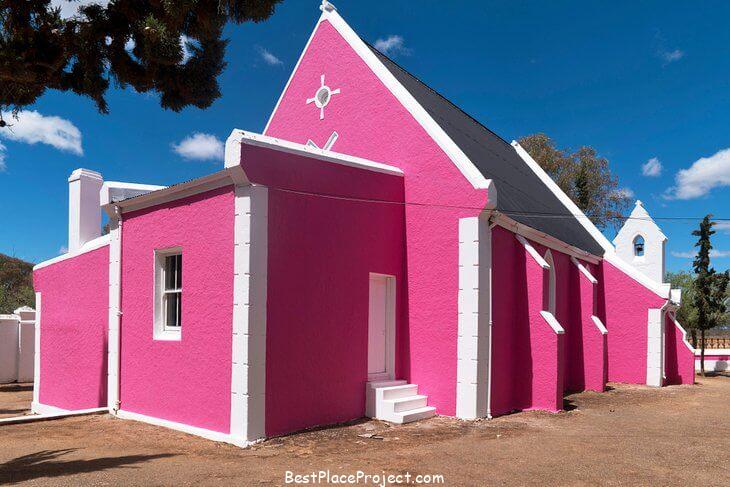
Matjiesfontein is a strange little town in the Little Karoo. It is about halfway between Cape Town and Beaufort West.
In 1880, a Scotsman named James Logan moved here and opened a spa because the dry air had helped him get better from a long-term lung illness.
The spa was a big hit, and in the late 1800s, it attracted rich and famous people like the Sultan of Zanzibar and Winston Churchill’s father, Lord Randolph Churchill.
Matjiesfontein was made a national monument in 1975, and many Victorian-era buildings, like the elegant Lord Milner Hotel, are still there.
Staff dressed in clothes from the time period add to the feeling of history. Matjiesfontein is a popular place for South Africans to go on weekend trips, and it is also a stop for international travellers going from the middle of the country to Cape Town by train.
6. Oudtshoorn
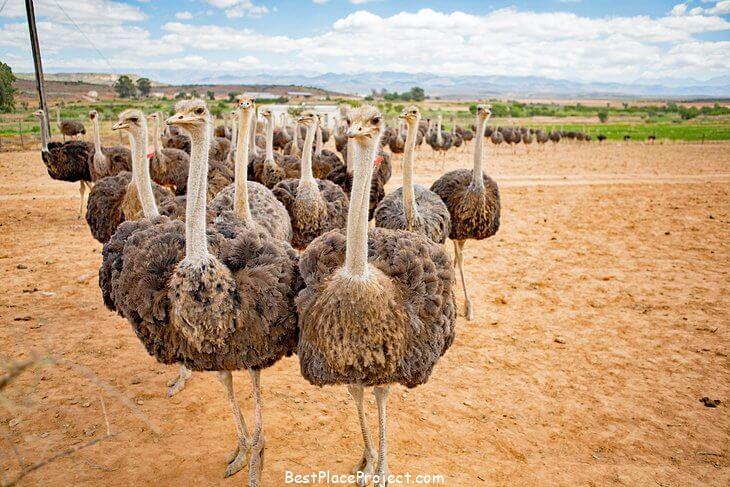
All you can do in Oudtshoorn is see ostriches. This small town in the Klein Karoo, between the Outeniqua and Swartberg Mountains, calls itself the “ostrich capital of the world.” In fact, restaurants serve everything from ostrich egg omelettes to ostrich steaks, and shops are full of ostrich feather dusters, ostrich leather purses, and even ostrich biltong, which is like jerky but made from ostrich meat.
Around Oudtshoorn, there are also a lot of farms that raise ostriches and offer tours. One of these places is the Highgate Ostrich Show Farm, which is 10 km south of town. Back in town, the C.P. Nell Museum tells the story of Outdshoorn’s connection to this bird that can’t fly. It starts with the first boom in ostrich feathers, which happened from 1865 to 1870.
If you are tired of seeing ostriches, go to the Cango Caves in the north. They are a wild system of caves made of limestone that are 20 million years old and the biggest of their kind in all of Africa. This amazing underground wonder can be seen on tours.
5. Swellendam and Bontebok National Park
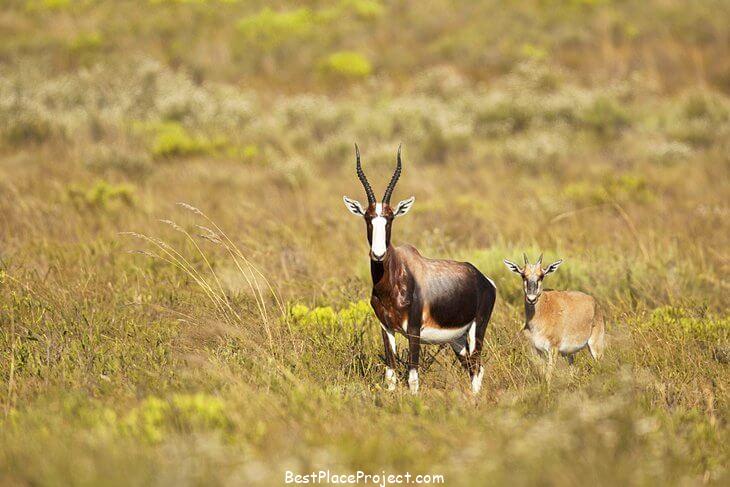
Swellendam is South Africa’s third oldest town and is well kept. It is on the N2 highway about 220 kilometres east of Cape Town. Most of the 50 heritage buildings in the town are built in the white Cape Dutch style. There are also a number of good restaurants and small hotels in the town.
The town is near the beautiful Langeberg Mountain Range. Two Feathers Horse Trails is a good place to go horseback riding. No matter if you are a beginner or an experienced rider, they can make the trail rides fit your needs.
Bontebok National Park, the smallest national park in South Africa, can be reached from Swellendam. The park was made in 1931 so that the bontebok, which is a medium-sized antelope, could stay safe.
4. Gondwana Game Reserve
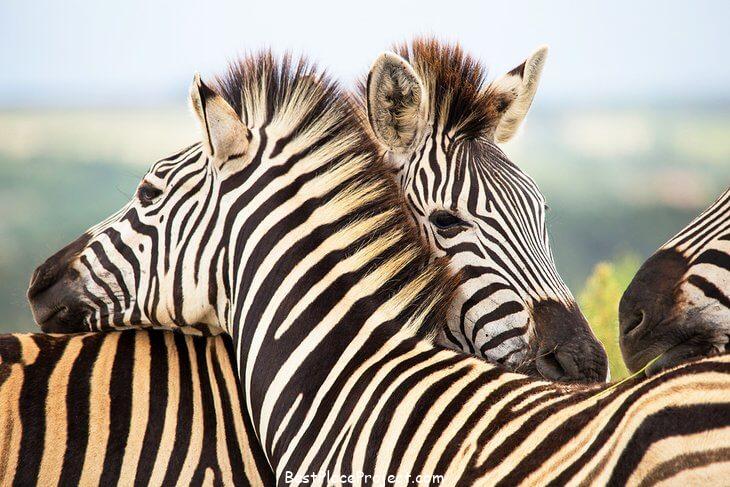
Even though safaris aren’t as popular in the Western Cape as they are in other South African provinces, you can still see the Big Five there. Yes, you can see the Big Five (lions, buffalos, elephants, rhinos, and leopards) and a lot of other African animals here, from giraffes to zebras.
For one of these, go to the Gondwana Game Reserve in Kleinberg on the Garden Route. There are a few different places to stay on the property. You can stay at the high-end Kwena Lodge, where the 14 suites are arranged in a circle and have big windows with 180-degree views.
Families will love the Fynbos Villas and Bush Villas. They are large homes with three or four bedrooms. They have kitchens and a dining room that opens onto a wraparound deck where you can watch wildlife and see stars all night.
There is also a tented eco-camp that is a very unique way to get involved in conservation work and have a safari experience in the wild. There are packages for three and five nights.
Gondwana is different from many South African wildlife reserves in that it offers a variety of packages, from all-inclusive with full board and game drives to bed and breakfast.
Address: R327 Heuningklip Farm, Herbertsdale, 6505
3. Montagu
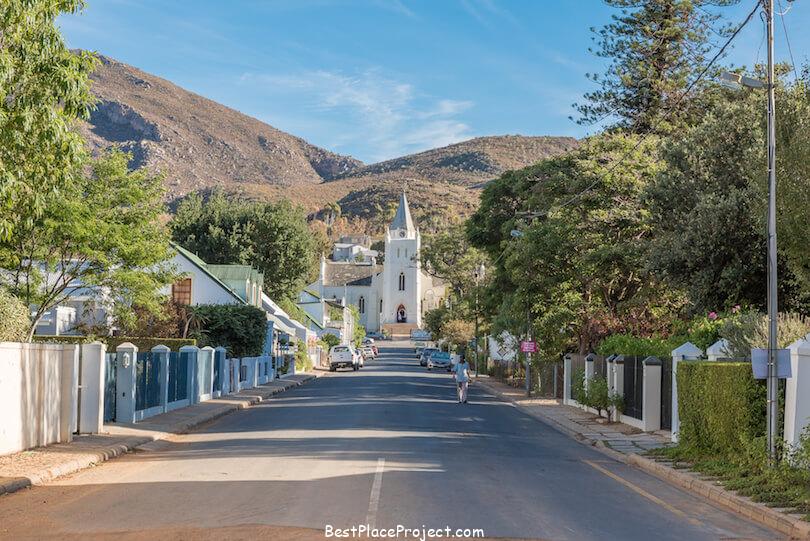
Nestled away in the Langeberg Mountains with rivers either side of it, it’s not without good reason that the small town of Montagu is known as the ‘mountain mecca.’
Famed for its fantastic wineries and vineyards, its scenic setting, and healing mineral springs, Montagu really is a treat to visit. Many guests end up staying longer than they intended.
While its wonderful hot springs and beautiful gardens are perfect for relaxing in, visitors can also go abseiling, mountain biking, or paragliding in the surrounding natural areas.
Lying along Route 62 – the country’s very own version of Route 66 in the States – Montagu is also a great base from which to explore the Klein Karoo.
2. Robben Island
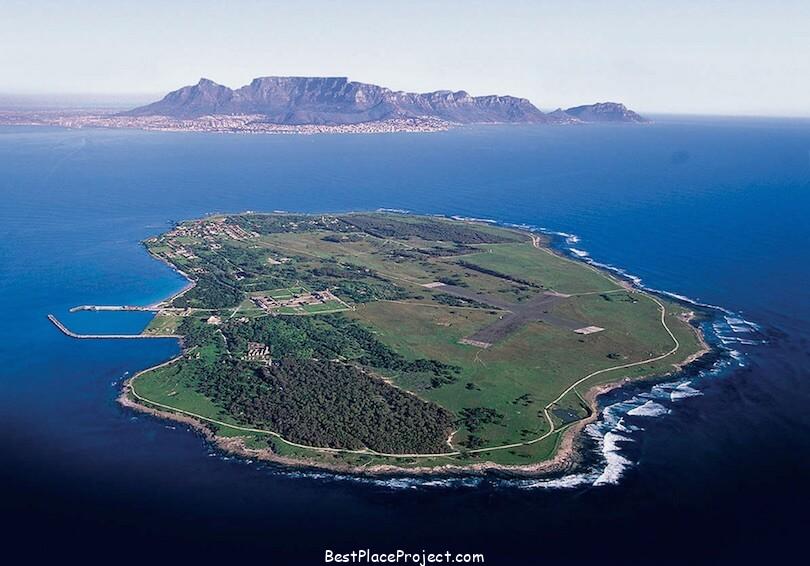
Located just off the coast of Cape Town in Table Bay, it is on Robben Island that Nelson Mandela was famously imprisoned for 18 of his 27 years spent in jail as he protested against the apartheid regime in South Africa.
While the island has mainly been used throughout its history to house political prisoners, nowadays, it is a popular museum and tourist attraction. Many people come to the former prison to learn about both the lives of its former inmates and life in South Africa under both colonial rule and apartheid.
A very interesting and moving place, visiting Robben Island is a must for anyone interested in learning more about the country’s troubled past.
1. Paternoster
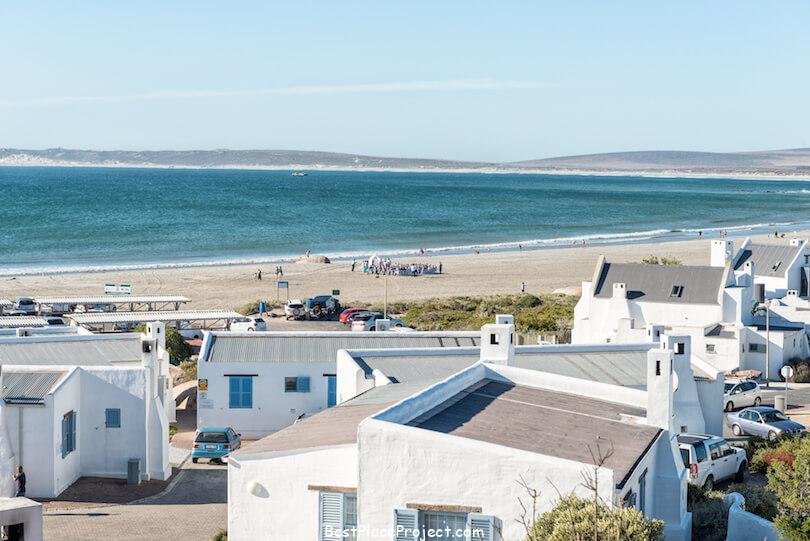
One of the oldest fishing villages in the Western Cape, sleepy, laidback Paternoster is a great place to head to if you’re looking for a quiet holiday. The white-washed cottages, rugged coastline, and beautiful white-sand beaches certainly make for a scenic setting.
Although ideal for people looking to kick back and relax, Paternoster also has a wealth of great outdoor activities for you to enjoy, with hiking and mountain biking around the Cape Columbine nature reserve particularly popular pastimes.
In addition to this, visitors can also go kayaking, snorkeling, and scuba diving, or even take a dolphin or whale watching tour to catch a glimpse of the area’s abundant marine life.
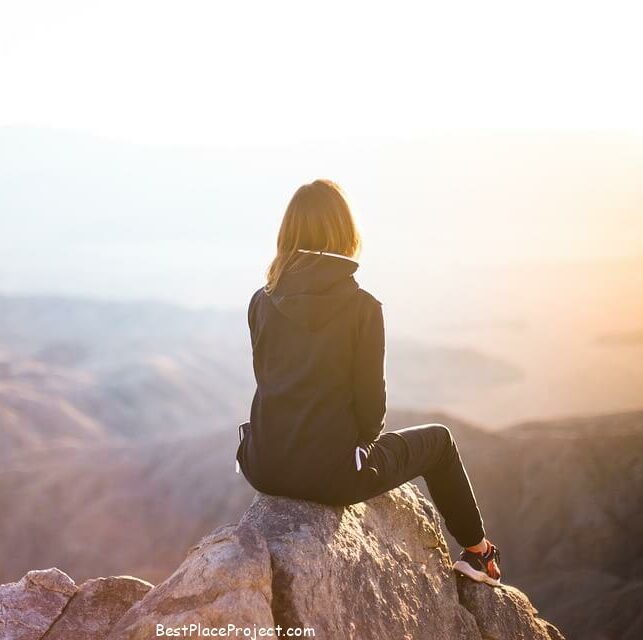
I love traveling and exploring new places and this website is all about listing all best places in the world that you can go and explore.
